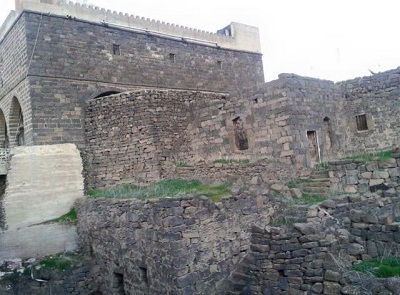(ST) – Abiba is the ancient name of a town called “Khabab” in Horan. It is located in Daraa province in Syria, about 55 km from Damascus and 60 km from Daraa.
The word “khabab” is an Assyrian Acadia word which means light and bright under this source comes the word Aeb which means lightness and soft green. It is worth mentioning that there is an adjacent village to Khabab called Abe, and the name was derived from it the word Abiba and means “Stunned barley staple” and in the Pharos the word “Abib” means “the month of April,” in which the sabbaths ripen and in Syriac we say Abba and means a flower or the yield of the fruit, as well as the word Hababa and Khababa comes from intense love.
In the Scientific Academy Magazine of the Patriarch Mar Ignatius I, Volume 23 /C1/ edition in the first of April 1948 says in his article entitled: Syriac words in the Arabic dictionaries of the verb in the Old Chaldean that the word means “the land is productive and fruitful”.
As an old popular legacy, the name of the village is mentioned in several names, including “Hababa”, “Khababa”, “Abbe” and the origin of the root is “Assyrian Acadi” (Ababee) which means light and bright, indicating its ancient richness with water, springs and fertile soil.
The ancient name of the town is “Ibiba” which is engraved on a stone in the western wall for the upper building of one of the houses in the center of the village, and the language that was written is Greek and the date of this inscription backs to 213 AD. There is another inscription in one of the houses also dates to the year 303 AD.
The name Abiba means the green lawn in the old Syrian languages. Abiba or Khabab is an important Christian center in the east. It is the seat of the diocese of Bosra, Horan and Jabal al Arab, an important archaeological town, where the region is rich in Roman, Byzantine and other monuments. It was inhabited by Roman Catholic Christian tribes.
The spread of buildings dates back to different periods of history and confirms the human settlement, and some of these buildings and material waste date back to the first millennium BC, the Aramaic period. Many of the buildings date back to the classical Greek, Roman and Byzantine periods. The roots of its population extend to the Arab tribes of Ghassan and Kinda. The current residents came from their Ghassani Emirat in ‘Salkhad”, their old town in Sweida province, in 1656-1721. The residents are an extension of the tribes of the Arab Ghassani what are called the indigenous Ghassani who departed from” Salkhad” to “Abiba”.
The settlement in the town dates back to ancient times, where the Greeks, Armenians and Romans lived. Modern housing dates back more than 280 years. The spread of buildings dates back to different eras of history, whereas the spread of buildings that backs to different eras of history confirms the oldness of human settlements in the town. Some of the buildings and residues date back to the Aramean era and many of the buildings back to classical era of “Greek, Roman and Byzantine”.
As for the Arabic language in the dictionary of Al Muheet “The Ocean”, the word “Khabab” means “the sound of running horses in the rugged areas”. Thus, we can say that the word Khabab comes from the Canaanite, Aramaic, Assyrian and Akkadian source, which is about three thousand years old. These words were interpreted by Bishop Mattha Rohm, Bishop of al Hasakah of the Greek Orthodox (Khabab is a village of Horan). All these explanations confirm that the village was rich in water and springs. This freshness and brightness of its agricultural fertility and its important position in the bosom of the al Lajat area between the plain and the rugged area. This view was confirmed by the worship of the ancient goddess Tika, where she was patronizing them to protect their plantations and palaces.
Two inscriptions were written in the Greek language, the first is located in the house of the priest, Jeryes Salman, in the center of the town. It was brought from a farm in al Zabera affiliated to Khabab. The inscription was interpreted by the English archaeologist Eddington and dated to 213 AD under the reign of Emperor Marcus Severus Antonius. The second inscription is of the origin of the building, which is found in the house of Salama al Ghazi and dates back to the year 303 AD during the reign of Emperor Diocletian VI and the mandate of Emperor Maximian VII and was built by Aurelius Iris Avid at his own expense, the Temple of Goddess “Tika”.
Sharif al Khatib

